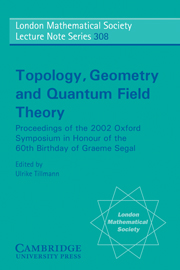 Topology, Geometry and Quantum Field Theory
Topology, Geometry and Quantum Field Theory Book contents
- Frontmatter
- Contents
- Preface
- Participants
- Introduction
- Part I Contributions
- 1 A variant of K-theory: K±
- 2 Two-vector bundles and forms of elliptic cohomology
- 3 Geometric realization of the Segal–Sugawara construction
- 4 Differential isomorphism and equivalence of algebraic varieties
- 5 A polarized view of string topology
- 6 Random matrices and Calabi–Yau geometry
- 7 A survey of the topological properties of symplectomorphism groups
- 8 K-theory from a physical perspective
- 9 Heisenberg groups and algebraic topology
- 10 What is an elliptic object?
- 11 Open and closed string field theory interpreted in classical algebraic topology
- 12 K-theory of the moduli space of bundles on a surface and deformations of the Verlinde algebra
- 13 Cohomology of the stable mapping class group
- 14 Conformal field theory in four and six dimensions
- Part II The definition of conformal field theory
- Foreword and postscript
- The definition of CFT
- References
2 - Two-vector bundles and forms of elliptic cohomology
Published online by Cambridge University Press: 06 November 2009
- Frontmatter
- Contents
- Preface
- Participants
- Introduction
- Part I Contributions
- 1 A variant of K-theory: K±
- 2 Two-vector bundles and forms of elliptic cohomology
- 3 Geometric realization of the Segal–Sugawara construction
- 4 Differential isomorphism and equivalence of algebraic varieties
- 5 A polarized view of string topology
- 6 Random matrices and Calabi–Yau geometry
- 7 A survey of the topological properties of symplectomorphism groups
- 8 K-theory from a physical perspective
- 9 Heisenberg groups and algebraic topology
- 10 What is an elliptic object?
- 11 Open and closed string field theory interpreted in classical algebraic topology
- 12 K-theory of the moduli space of bundles on a surface and deformations of the Verlinde algebra
- 13 Cohomology of the stable mapping class group
- 14 Conformal field theory in four and six dimensions
- Part II The definition of conformal field theory
- Foreword and postscript
- The definition of CFT
- References
Summary
Introduction
The work to be presented in this paper has been inspired by several of Professor Graeme Segal's papers. Our search for a geometrically defined elliptic cohomology theory with associated elliptic objects obviously stems from his Bourbaki seminar. Our readiness to form group completions of symmetric monoidal categories by passage to algebraic K-theory spectra derives from his Topology paper. Our inclination to invoke 2-functors to the 2-category of 2-vector spaces generalizes his model for topological K-theory in terms of functors from a path category to the category of vector spaces. We offer him our admiration.
Among all generalized (co-)homology theories, a few hold a special position because they are, in some sense, geometrically defined. For example, de Rham cohomology of manifolds is defined in terms of cohomology classes of closed differential forms, topological K-theory of finite CW complexes is defined in terms of equivalence classes of complex vector bundles, and complex bordism is defined in terms of bordism classes of maps from stably complex manifolds. The geometric origin of these theories makes them particularly well suited to the analysis of many key problems. For example, Chern–Weil theory associates differential forms related to the curvature tensor to manifolds with a connection, whose de Rham cohomology classes are the Chern classes of the tangent bundle of the manifold. The Atiyah–Segal index theory associates formal differences of vector bundles to parametrized families of Fredholm operators, arising e.g. from complexes of elliptic pseudo-differential operators, and their isomorphism classes live in topological K-theory.
- Type
- Chapter
- Information
- Topology, Geometry and Quantum Field TheoryProceedings of the 2002 Oxford Symposium in Honour of the 60th Birthday of Graeme Segal, pp. 18 - 45Publisher: Cambridge University PressPrint publication year: 2004
- 22
- Cited by


